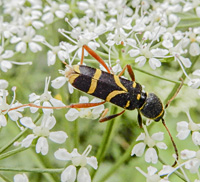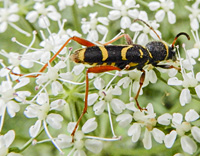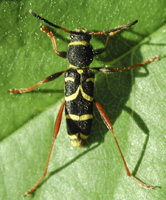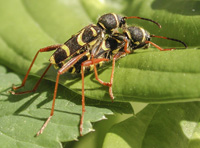[All pictures of garden wildlife on this page are thumbnails. Click on any thumbnail for a large format to be displayed.]

Wasp Beetle (Clytus arietis)
| Taxonomy | ||||||
|---|---|---|---|---|---|---|
| Kingdom: | Phylum: | Class: | Order: | Family: | Genus: | Species: |
| Animalia | Arthropoda | Insecta | Coleoptera | Cerambycidae | Clytus | C.arietis |
Some flies protect themselves from preditors by mimicking the looks and movements of wasps. Some beetles, Wasp Beetle is one of them, use the same trick. At the first glance the beetle looks like a dangerous wasp. But when you look closely you will notice that the abdomen is covered with shields rather than thin transparent wings. This is an important feature distinguishing beetles from wasps. So, even though Wasp Beetle is not actually dangerous to you, it just uses a wasp's colours to scare potential enemies off. No other species in Western Europe is such a good immitator of a wasp.
The Wasp Beetle hardly measures 9-18mm. The body is black with yellow lines, which even run on the underside of the body. The legs are red. And the antennae are special too. First of all they are quite short for a Longhorn Beetle. Secondly the are very flexible. The beetle constantly moves its antennae, just like many wasps do. Adult beetles can be mainly seen in May, June and July. The males are strict vegetarians, usually eating only pollen. The females are known to catch other insects from time to time. They probably need additional proteins to produce the eggs. Adult Wasp Beetles live for only a few weeks. The larvae live for about one and a half years in rotting and moulding trees and wood. They have preference for beech wood, but can be found in other trees as well.

© Copyright 1998-2024 gardensafari.net (Hania Berdys)

 English / engels
English / engels  Dutch / nederlands
Dutch / nederlands








